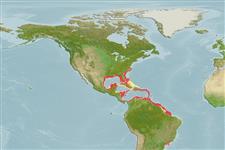Common names from other countries
>
Ophidiiformes (Cusk eels) >
Ophidiidae (Cusk-eels) > Ophidiinae
Etymology: Lepophidium: Latin, lepus, leporis = rabbit + Greek, ophis = serpent (Ref. 45335).
More on author: Cuvier.
Environment: milieu / climate zone / depth range / distribution range
Ecologia
marinhas demersal; intervalo de profundidade 5 - 115 m (Ref. 91765). Tropical; 36°N - 26°S, 98°W - 43°W (Ref. 91765)
Western Atlantic: widespread along the Atlantic coast of the United States (from North Carolina), through the Gulf of Mexico and the Caribbean, to the coasts of South America (up to Uruguay); apparently absent in the Bahamas.
Tamanho / Peso / Idade
Maturity: Lm ? range ? - ? cm
Max length : 28.8 cm SL macho/indeterminado; (Ref. 128822); common length : 20.0 cm TL macho/indeterminado; (Ref. 5217)
Descrição breve
Morfologia | Morfometria
Espinhos dorsais (total): 0; Raios dorsais moles (total): 120-134; Espinhos anais 0; Raios anais moles: 99 - 110; Vértebras: 69 - 74. Rostral spine long and curved, reaching tip of snout, without vertical basal component; peritoneum pale; no median basibranchial tooth patch; head extensively covered with imbricate rows of cycloid scales except for snout and throat; body tapering to point, dagger-shaped (Ref. 34024). Body dark gray or brownish gray without blotches; dorsal and anal fins dark, becoming gradually darker at the extreme blackish edge; pelvic fin blackish in anterior half and pale in posterior half; gill arch blackish or brownish; head covered with scales except for snout, lips, and branchiostegal membrane (Ref. 13608).
Common species (Ref. 34024). Found on soft bottom (Ref. 7251). Oviparous, with oval pelagic eggs floating in a gelatinous mass (Ref. 205).
Life cycle and mating behavior
Maturidade | Reprodução | Desova | Ovos | Fecundidade | Larvas
Robins, C.R., R.H. Robins and M.E. Brown, 2012. A revision of Lepophidium (Teleoastei, Ophidiidae), with descriptions of eight new species. Bulletin of the Florida Museum of Natural History 52(1):1-94. (Ref. 91765)
Categoria na Lista Vermelha da IUCN (Ref. 130435)
CITES (Ref. 128078)
Not Evaluated
Ameaça para o homem
Harmless
Utilização humana
Pescarias: pouco comercial
Mais informação
ReferênciasAquaculturaPerfil para aquaculturaEstirpesGenéticaElectrophoresesHereditariedadeDoençasProcessamentoMass conversion
Ferramentas
Relatórios especiais
Descarregue XML
Fontes da internet
Estimates based on models
Preferred temperature (Ref.
115969): 21.8 - 27.8, mean 26 (based on 464 cells).
Phylogenetic diversity index (Ref.
82804): PD
50 = 0.5000 [Uniqueness, from 0.5 = low to 2.0 = high].
Bayesian length-weight: a=0.00269 (0.00156 - 0.00465), b=3.11 (2.96 - 3.26), in cm Total Length, based on LWR estimates for this species & Genus-body shape (Ref.
93245).
Nível Trófico (Ref.
69278): 3.6 ±0.7 se; based on size and trophs of closest relatives
Resiliência (Ref.
120179): Médio, tempo mínimo de duplicação da população 1,4 - 4,4 anos (Preliminary K or Fecundity.).
Fishing Vulnerability (Ref.
59153): Low to moderate vulnerability (25 of 100).
